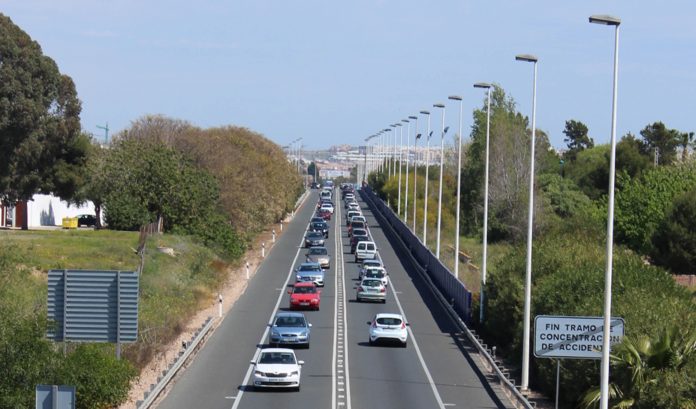Those who believe that the N-332 traffic jams will shortly be consigned to history have learned hat they will have to wait a little longer to see what happens, since Fomento, the Ministry of Development, has now decided to commission an environmental impact study that will determine the feasibility of the work.
As such it is now likely to be at least in 2020 before the Government begins construction project to carry out the works of a section of single carriageway that supports over 40,000 vehicles a day, and that, during the Easter and Summer months, reaches 50,000 vehicles daily circulating on a single lane road, in each direction.
With more than 10 years of delays, protests and demands, the Torrevieja public and users of the National Highway 332, have had to wait for Fomento to assume responsibility for the upgrade to dual carriageway of the Torrevieja variant.
The stretch of the N-332 in question is a conventional road with good features and links. However, what motivates the current tender, at a cost of 40M euros, is the objective of improving the capacity and giving more fluidity to the traffic.
Despite being one of the most trafficked areas, it gives access to large shopping centres, such as Carrefour, Habaneras; to Hospitals and to a large network of urbanizations that form a substantial part of the population around the urban centre of Torrevieja.
This situation becomes more complicated during the summer months, when the urbanisations are full of tourists, who use this road every day as access to the beach areas. The opening in 2012 of the shopping centre at ‘Zenia Boulevard’ did nothing but increase the traffic jams to a road that was already saturated by traffic.
The new road will have the characteristics of a multi-lane highway. It will have two roads with two lanes, each 3.5 meters wide.
It should be remembered that sections of the N-332 have already been upgraded from Guardamar to Torrevieja to four lanes, and its capacity was also extended between Torrevieja and Pilar de la Horadada. Works that, according to the national deputy, Herick Campos, “are due to the investments made by the PSOE and that involved an investment of 28 million euros on each occasion.”
The mayor of Torrevieja, José Manuel Dolón has carried out a number of different measures to get the work started as soon as possible. Some of them have been by extensive use of the media, to highlight the grievances of the Torrevieja public. He says that “it is a necessity to act once and for all on this obstacle that is marking our economic, tourist and social development “.
Road users not only have to endure the unpleasant delays, delays and traffic jams, with all the inconveniences this may cause. Beyond these inconveniences, there is a serious problem of road safety that puts the lives of those who use this stretch at serious risk. This has been highlighted by the General Directorate of Traffic (DGT) as a dangerous black spot, which is why it is urgent to reach a definitive solution to this problem.
One solution that the DGT has introduced to resolve the problem is to increase the number of speed control radars. A measure that has not sat well with users which they see more as a fundraising move than a solution to increase their safety at the wheel.
Last December, the DGT installed a further radar camera at this black spot on the Torrevieja stretch and another on the same road in Santa Pola.
The N-332 is a road not without controversy in other areas of the province of Alicante, some of them sadly known for the large number of accidents that regularly occur. The road runs through the province from Torrevieja to Denia, passing through Guardamar, La Marina, Santa Pola and El Altet. It also passes through San Juan, El Campello, Villajoyosa, Benidorm, Altea, Calpe, Benisa, Ondara, Jávea and Denia. The regular dangers are present along the whole route.
Many of the affected municipalities have denounced on several occasions the lack of investments to improve the state of the road. It is evident in some areas that not even adequate maintenance is being carried out, that there are several black spots, some of them impossible to avoid by the drivers since the only alternatives are to detour through urban centres.
The situation is aggravated along some stretches of the road that are frequented by cyclists, due to the mountainous terrain that it has, so it is very attractive for the practice of this sport. The consequences cannot be more dramatic as there are many cyclists who lose their lives in this area every year.
Those many municipalities affected by this situation, ask that the competent administrations act immediately. And one of their proposals, as a possible solution, involves the release of the AP-7 toll road, which would allow the elimination of tolls.
Their elimination could, as some mayors insist, reduce the high accident rate in some sections of the N-332, mainly as it passes through tourist towns that are saturated during the summer. However, it does not seem that this solution is among the plans of the Central Executive, at least in the short term.
So, despite the fact that Investment in roads has fallen by 56% in the province of Alicante, the Torrevieja mayor has asked for speed so that the works are not delayed. He has shown the willingness of the City Council to collaborate wherever it is necessary. But, he also says that he now appreciates that in the best of cases, it will be necessary to wait for at least another two years for the works to begin.





